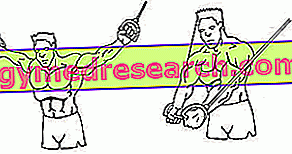Edited by Giovanni Bruno
Cross-over to cables, in my opinion, is one of the best exercises, one of those that, if done well, with perfect execution and relatively light load, really feel on our bibs, perhaps one of the most "precise" exercises in the hit the target muscle. In fact, thanks to the tension of the cable, compared to the crosses with only the handlebars, the muscular work is much more intense.

PERFORMANCE
- Grab the stirrup handles of the two high pulleys with a pronation grip (palms facing down) and arms slightly higher than the shoulders.
- Bend forward about 15 degrees, with your back in its natural arched position.
- In the initial position, the arms are located outside and to the sides, perpendicular to the body, with the elbows slightly bent and locked in this angle.
- Inhale and hold your breath as you start pulling the handles downward with relatively straight arms.
- As you approach the sides of the trunk, bring your arms slightly forward until you barely touch or cross.
- After holding the lower position for a moment, begin to exhale and return the arms to the initial position.
- Keep the body stable throughout the exercise.
TECHNICAL ADVICE
- Keeping the elbows slightly bent helps relieve the stress they should instead bear if they were lying down. Furthermore, performing the movement with the arms straight activate the triceps at the expense of the pectorals.
- Keep the torso in the same position throughout the movement. If you lean forward to promote arm movement, you will reduce the load on the pectorals.
- Pull your arms towards your chest, keeping them as aligned as possible with your pectorals. If you move them towards the head, you will move part of the load onto the upper pectorals and the front deltoids.
- In general, bending further forward shifts the load to the central and upper part of the pectorals. Conversely, an upright position favors the work of the lower part.
- To improve the stability of the trunk, which is extremely important in this exercise, inhale and hold the breath during the phase of pulling and crossing. This increases the intra-abdominal and thoracic pressure, which helps to improve the stability of the spine. On the contrary, exhaling during exertion, one experiences a decrease in strength and inability to maintain a straight back, with consequent risk of trauma.
- Since the abduction of the scapula involves the large dentate, do not contract the back muscles to keep the shoulders back, but let them curl forward when the arms are in front of the torso.
DON'T LEAVE THE ARMS TO MAKE THE BIG WORK. TO KEEP THE LOAD ON THE BREAST, KEEP THE ELBOWS LOCKED AND SLIGHTLY FOLDED AND CONTRACT THE BIBS WHEN YOU BRING THE ARMS IN FRONT OF THE BUST.
Kinesiology
In the shoulder joint, the most activated muscles are the pectoralis major, the anterior deltoid and the coraco-brachialis. The major pectoral covers the entire chest region, but this exercise mainly activates the central and upper part. The deltoid instead covers the surface of the shoulder and is divided into three parts; the crossovers only activate the front end. The coraco-brachial is a small deep muscle located below the deltoid and the pectoralis major. In the shoulder girdle, the main muscles activated are the large dentate (serratus anterior) and the pectoralis minor. The first one located on the external part of the ribs is covered by the scapula in the inner part and by the greater pectoral in the front one. The minor bib is covered by the major.
In the articulation of the shoulder the action is that of the horizontal adduction, in which the arms are placed at the bottom and inwards on a vertical plane. Activation of the bib starts when the arms move downwards. As they pass in front of the bust, the emphasis shifts to the central and inner part of the pectoralis major. In the shoulder girdle an abduction of the scapula takes place, which moves downwards with the arms.
Try this exercise after a few months of serious training, after you have acquired a bit of lean mass to work with, but perform it perfectly: it makes no sense to put on weight at the expense of execution, it would not bring results; perform it with a slow performance, a TUT 2-0-3 could be fine. Then let me know if I'm right!



